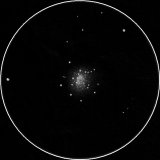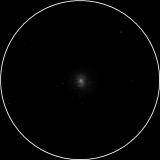
| MESSIER 92 |
|---|
RA: |
17h 17m 06s |
|
DEC: |
+43° 08' 00'' |
|
Type: |
Globular cluster |
|
NGC: |
6341 |
|
Magnitude: |
6.50 |
|
Surface brightness : |
11.00 |
|
Apparent dimensions : |
11.2'x11.2' |
|
Distance: |
26,700 ly |
|
Globular cluster M92 is one of the original discoveries of Johann Elert Bode, who found it on December 27, 1777. Charles Messier independently rediscovered it and cataloged it on March 18, 1781, the same day as he cataloged another 8 objects, all of them Virgo Cluster galaxies (M84-M91). It was William Herschel who first resolved it into stars in 1783. According to newer sources, M92 is about 26,000 light years distant, only little more than its brighter apparent neighbor M13. It may be a bit younger than M13 as its turnoff point is shifted to the brighter and bluer end. M92 is a splendid object, visible to the naked eye under very good conditions and a showpiece for every optics. It is only slightly less bright but about 1/3 less extended than M13: its 14.0' angular extension corresponds to a true diameter of 109 light years, and may have a mass of up to 330,000 suns. This globular cluster is well known for having dense core which requires large telescope to resolve. In 8" telescope, outer parts of cluster are well resolved and about 30 faint stars is visible. |
||
Other sketches |
|||||
 |
|||||
M92, May 2006. |
|||||
VEDRAN VRHOVAC© 2006.-2007. |
